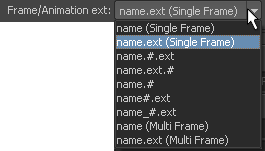For information on the file name syntax, see Subfolders and names of rendered images.
Note: You can also set the file name of rendered files when you render from a shell or command line, using
Render and the
-im option.
See About command line rendering for information about command line rendering.
To set the file name (syntax) for rendered images
- In the File Output section of the
Render Settings window, set the following:
- File name prefix, (for example,
rocket):
Option Example name rocket name.ext rocket.iff name.#.ext rocket.1.iff name.ext.# rocket.iff.1 name.# rocket.1 name#.ext rocket1.iff Attention:- If you select an option that does not contain #, Maya renders a single frame.
- If you select an option that does contain#, Maya renders an image sequence (animation). The top of the Render Settings window provides feedback for the output files.
- File name prefix, (for example,
rocket):
-
Frame/Animation Ext to the combination and order of base name (name).

- File format extension (ext).
- Frame number extension (#) you want rendered files to have.
- Start Frame to the first frame you want to render and End Frame to the last frame you want to render.
- By Frame to the increment between frames you want to render.
- Frame Padding to the number of digits you want in frame number extensions.
To use a custom file format extension for rendered images
- The file format extension is the standard file format extension for the current Image Format setting. To change that, in the File Output section of the Render Settings window, turn on Use Custom Extension and type the extension you want to use.